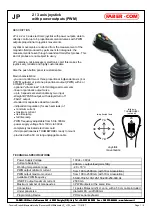
10
Configuration
T delay
Injection
point
Sensor
m/s
Example: For a flow rate of 200,000 l/h of water and a PpH = 1, proportional dosing of acid will be: (1 /
100,000) x 200,000 l/h = 2 l/h
The proportion needed to achieve a specific pH will depend not only on its nature and concentration, but
also on the nature of the water to be treated and the rest of the dosed products that can influence this
parameter.
- Kp:
Proportional constant for the control. This parameter enables adjustment of the amount of device
response based on the difference between the reading and the setpoint (Error). A value that is too high
can produce a reaction that is too abrupt for the system and exceed the setpoint value in the tank, leading
to a risk situation. A value that is too low will produce a slow approach to the setpoint.
- Ki:
Integral PI adjustment. This parameter acts on the accumulated error and enables reading stabilisation
once the setpoint value has been achieved. It is only valid for in-line controls. For recirculating controls it
must be Ki=0.
- T delay (seconds):
T delay is the time between two consecutive controller orders to position the regulating output. For a
proper regulation, this time has to be greater than it takes fro a drop of dosed product to travel from the
injection point to the point where the pH or EC sensor is located.
- Q test:
Reference flow rate for T delay that allows for automatic adjustment of T delay with changes in water flow
rate, so that T delay is always at an optimal value. To keep T delay fixed, leave Qtest = 0.
Example: In a 8" pipe through which water passes at 100 m3/h, the water speed is approximately 1 m/s.
If the distance between the injection point and the sensor is 10 metres, the installation delay time is 10
seconds.
The sensor will have a reaction time (approximately 10 seconds for the pH sensor), which must be added
to the installation delay time. Therefore, a T delay = 20 seconds should be set.






































